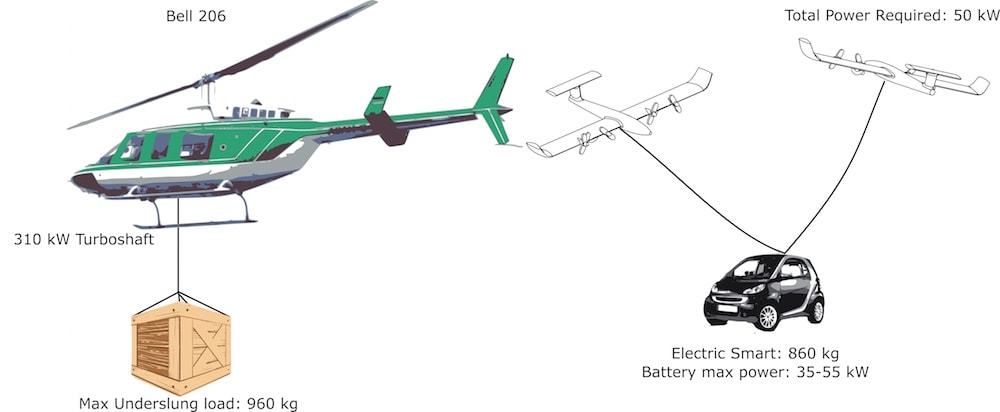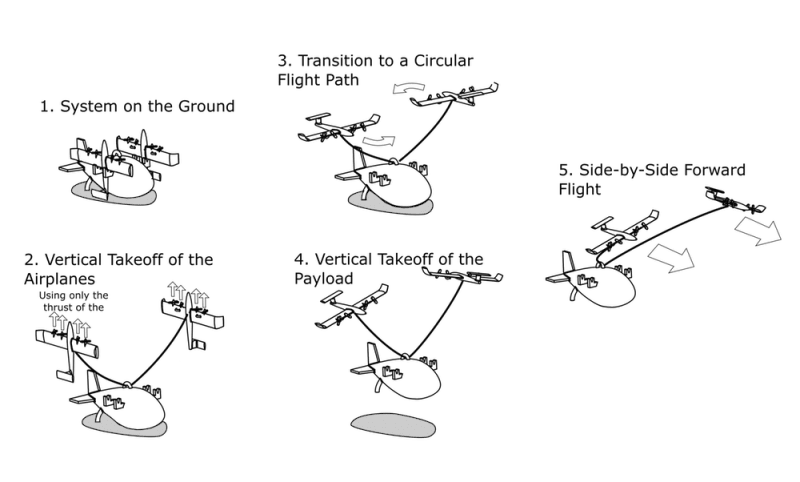Conventional helicopters usually represent a compromise between hovering capabilities and cruise speed. While many new configurations are aimed at improving the speed and maneuverability, such as tilt-rotors and compound helicopters, few of them attempt to increase the load lifting capabilities in hover. The proposed system uses a novel approach to provide efficient load lifting capabilities while maintaining a high efficiency in cruise: the large rotor required to perform heavy lift is replaced by two or more unmanned electric airplanes flying in circle, tethered to the payload.
Electric conductors are included in the tethers to transfer electric power from the payload to the aircraft. Such architecture allows the airplanes to be light since no energy source is stored on-board and takes advantage of the high power density of electric motors. Moreover, the concept of distributed electric propulsion is used to enhance the performance of the wing in slow speed condition and reduces the noise level to a minimum.
For the takeoff phase (see Figs), the aircraft use solely the thrust of their propellers to overcome gravity in a “tailsitter” configuration. The systems remains compact near the ground since the airplanes are not yet rotating around the payload.
The aircraft can then transition from the stationary flight to a circular flight path over the payload, increasing their airspeed until enough lift is provided so that the payload is lifted off the ground. Finally, the cruise configuration is characterized by the aircraft flying side-by-side taking advantage of positive aerodynamic interaction. A high efficiency is maintained in this flight phase compared to conventional helicopters since the reconfigurable rotor system does not suffer from the reverse flow condition and unsteady aerodynamics. The landing process is similar in the opposite order. Advanced control systems have already been developed for such maneuvers which reduces the development risks.
The advantages of the reconfigurable rotor concept over conventional helicopters are numerous. First, the system shows a high efficiency throughout its flight envelope, with a payload capacity of over 18 tons with only 1,200 kW of required power, or about 10% of what is required for an equivalent conventional helicopter. Second, Initial studies showed an increase in reliability due to the high number of electric motors and low mechanical complexity. Third, the use of distributed electric propulsion reduces the noise levels which is critical for its use in populated area. Fourth, the system is expected to be safer since the vortex ring state can be easily mitigated at any vertical descent rate.
Such system could be used in various applications such as the transport and installation of off-shore wind turbines components. Because the power required to hover is significantly reduced compared to conventional helicopter, the proposed system could also be used to keep payloads in stationary flight for very long periods of time. It could be used as a very high communication antenna after a natural disaster where the time to rebuild the communication network is critical, or be used as an atmospheric satellite.
Like this entry?
-
About the Entrant
- Name:Erp2 Team
- Type of entry:teamTeam members:David Rancourt
Etienne Demers Bouchard - Software used for this entry:Matlab, Solidworks, QProp
- Patent status:pending








